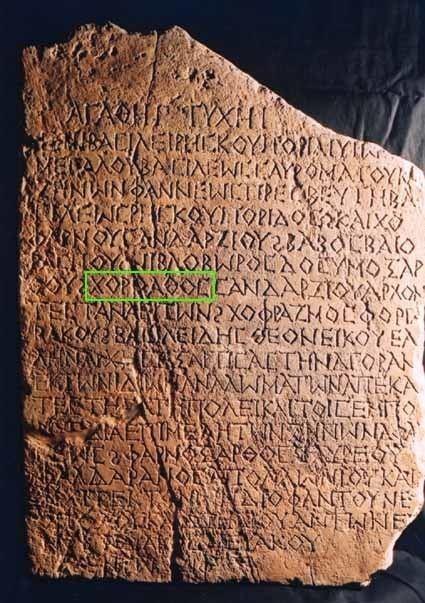 | ||
The name of Croatia (Croatian: Hrvatska) derives from Medieval Latin Croātia, itself a derivation of the native ethnonym, earlier Xъrvatъ and modern-day Croatian: Hrvat.
Contents
Earliest record
The first attestation of the term is in the Latin charter of duke Trpimir from 852 AD, whose original has been lost. A copy has been preserved in a 1568 transcript; Lujo Margetić has proposed in 2002 that the document is in fact of legislative character, dating to AD 840. In it is mentioned:
Dux Chroatorum iuvatus munere divino […] Regnum ChroatorumThe oldest stone inscription is the Latin Branimir Inscription (found in Šopot near Benkovac), where Duke Branimir is mentioned:
BRANIMIRO COM […] DUX CRUATORVM COGIT […]The earliest written monument in Croatian language, containing the ethnonym *xъrvatъ (khŭrvatŭ, IPA xŭrva:tŭ) is the Baška tablet from 1100 AD, which reads: zvъnъmirъ kralъ xrъvatъskъ ("Zvonimir, king of Croats").
Etymology
The exact origin and meaning of the ethnonym Hrvat (Proto-Slavic *Xъrvátъ) is poorly known and currently subject to scientific disagreement. It is believed, that the word might not be of native Slavic lexical stock, but a borrowing. Common theories from the 20th century derive it from an Iranian origin, the root word being a third-century Scytho-Sarmatian form attested in the Tanais Tablets as Χοροάθος (Khoroáthos, alternate forms comprise Khoróatos and Khoroúathos).
This form was used to substantiate the derivation of Proto-Slavic *xъrvatъ from the Old Persian xaraxwat-, attested by the Old Iranian toponym Harahvait-, the native name of Arachosia. "Arachosia" is the Latinized form of Ancient Greek Ἀραχωσία (Arachosíā); in Old Persian inscriptions, the region is referred to as Harahuvatiš (). In Indo-Iranian it actually means "one that pours into ponds", which derives from the name of the mythological Sarasvati River. However, although the somewhat suggestive similarity, the connection to the name of Arachosia is etymologically incorrect.
The first etymological thesis about the name of the Croats stems from Constantine Porphyrogennetos (tenth century), who connected the different names of the Croats, Βελοχρωβάτοι and Χρωβάτοι (Belokhrobatoi and Khrobatoi), with the Greek word χώρα (khṓra, "land"): "Croats in Slavic language means those who have many lands". In the 13th century, Thomas the Archdeacon considered that it was connected with the name of inhabitants of the Krk isle, which he gave as Curetes, Curibantes. In the 17th century, Juraj Ratkaj found a reflexion of the verb hrvati (se) "to wrestle" in the name.
In the 19th century, many different propositions were given, in order to interpret the Croatian ethnonym:
The 20th century gave rise to many new interpretations of the origin of the name of the Croats:
From the Iranian theses the most accepted is the derivation by Oleg Trubachyov from *xar-va(n)t (feminine, rich in women, ruled by women), which derives from the etymology of Sarmatians name, the Indo-Aryan *sar-ma(n)t "feminine", in both Indo-Iranian adjective suffix -ma(n)t/wa(n)t, and Indo-Aryan and the Indo-Iranian *sar- "woman", which in Iranian gives *har-. According to Radoslav Katičić this thesis doesn't entirely abide with the Croatian ethnonym, as the original form was Hrъvate not Hъrvate, and the vowel "a" in the desired Iranian harvat- is short, while in Slavic Hrъvate it is long. Katičić concluded that of all the etymological considerations the Iranian is at least unlikely.
The Medieval Latin name "Croātia" is derived from North-West Slavic xrovat-, by liquid metathesis from Common Slavic *xorvat-, from Proto-Slavic, i. e. Iranian, *xarwāt-. The Croatian ethnonym Hrvat in the Kajkavian dialect also comes in the form Horvat, while in the Chakavian dialect in the form Harvat.
Distribution
Croatian place names can be found in northern Slavic regions such as Moravia and Slovakia, along the river Saale in Germany, in Austria and Slovenia, and in the south in Greece and Albania.
Thus in the Duchy of Carinthia one can find Hrvatski kotar and Chrowat along upper Mura; in Middle Ages the following place names have been recorded: Krobathen, Krottendorf, Krautkogel; Kraut (before Chrowat and Croat) near Spittal. In the Duchy of Styria there are toponyms such as Chraberstorf and Krawerspach near Murau, Chrawat near Laas in Judendorf, Chrowat, Kchrawathof and Krawabten near Leoben. Along middle Mura Krawerseck, Krowot near Weiz, Krobothen near Stainz and Krobathen near Straganz.
In Slovenia there are Hrovate and Hrovača; in Germany along Saale river there were Chruuati near Halle) in 901 AD, Chruuati in 981 AD, Chruazis in 1012 AD, Churbate in 1055 AD, Grawat in 1086 AD, Curewate (now Korbetha), Großkorbetha (Curuvadi and Curuuuati 881-899 AD) and Kleinkorbetha, and Korbetha west of Leipzig; In Moravia are Charwath or Charvaty near Olomouc, in Slovakia are Chorvaty and Chrovátice near Varadka. The Charvatynia near Kashubians in district Neustadt is debatable.
In the southern Balkans, the Republic of Macedonia has a place named Arvati (Арвати) situated near lower Prespa; in Greece there is a Charváti (Χαρβάτι) in Attica and Harvation in Argolis, as well as Charváta (Χαρβάτα) on Crete; and Hirvati in Albania.
